| Area | West Branch Sheepscot |
| Topic | Tour: Calcein Fry Marking Study - U.S. Fish and Wildlife Service 2001 |
The primary goal of the study was to determine survival of calcein- marked Atlantic salmon fry and the secondary goal was to use calcein-marking to determine contribution of naturally-produced versus hatchery-produced Atlantic salmon fry to the total population in the West Branch Sheepscot River. This is a photo of the setup used to mark the fish. Photo by M. Halsted April 2001.
The sac fry are briefly submerged is a salt water solution to facilitate the uptake of the calcein into bony structures. Photo by M. Halsted April 2001.
After the salt bath, the sac fry are placed in the calcein, the greenish orange stuff. Calcein chemically binds with calcium in the fin rays, bones, and scales of the fish. Photo by M. Halsted April 2001.
The sac fry are then rinsed off and the marking process is completed. Photo by M. Halsted April 2001.
To view the calcein mark, a special light and filter are used. Photo by M. Halsted April 2001.
Once the calcein is bound, it is invisible to the naked eye but fluoresces bright green under specific lighting conditions. The marked fish have a florescent green glow from the bony structures. Photo by M. Halsted April 2001.
The fry were stocked into the West Branch in May 2001. Biologists from the USFWS, the MASC, and NOAA fisheries all helped to capture 0+ parr to look for the calcein marked fish by electrofishing in areas where they were stocked. Photo by M. Halsted September 2001.
Every 0+ parr captured was looked at for a calcein mark. This was done using a viewing bucket. Photo by M. Halsted September 2001.
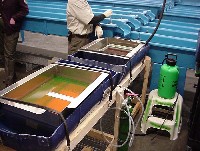 Click on image to enlarge (113K).
Click on image to enlarge (113K).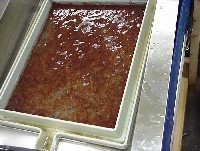 Click on image to enlarge (106K).
Click on image to enlarge (106K).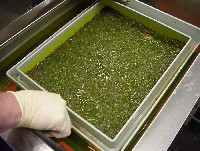 Click on image to enlarge (119K).
Click on image to enlarge (119K).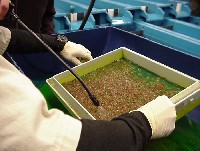 Click on image to enlarge (88K).
Click on image to enlarge (88K).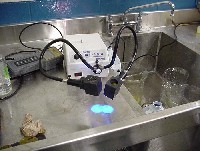 Click on image to enlarge (92K).
Click on image to enlarge (92K). Click on image to enlarge (50K).
Click on image to enlarge (50K).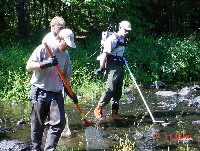 Click on image to enlarge (184K).
Click on image to enlarge (184K).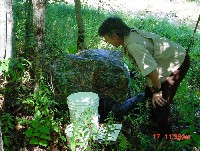 Click on image to enlarge (170K).
Click on image to enlarge (170K).
To learn more about this topic click Info Links
To view additional information (data source, aquisition date etc.) about this page, click Metadata
| www.krisweb.com |
